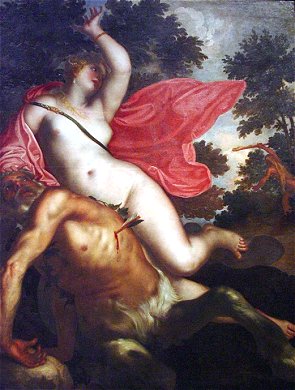 |
|
Deianira Abducted by the Centaur Nessus
by Padovanino (Allesandro Varotari) Italian 1588-1648
SN 142. Oil on Canvas 1627
by Robert Anderson. 2000
Artist
This artist, Padovanino ( Alessandro Varotari), was active - primarily in Venice from
approximately 1610. His early training is unknown but it is clear that the influence of
Titian started early and remained fundamental to the development of his art. While in
Rome, c. 1615-18, his painting showed the influence of Palma Giovane and a Manneristic
tradition but by 1625 he was adhering with increasing purity to 16th century Venetian art
and to Titian.
The artist developed a subtle decorative quality by 1631 and this was to
characterize many later works. His color harmonies became even richer in his later works
and he developed, with a brilliant vivacity, the color he had derived from Titian at the
start of his career.
Padovanino was successful in reviving 16th century art - Titian's style -
and by doing so obtained many commissions from important private collectors. Many of the
intellectuals of the day appreciated the learned and esoteric humanist themes of
Padovanino's work. |
Both Pietro della Vecchia and Giulio Carpioni were disciples of his art.
Subject
Hercules, the son of Jove, was travelling with his new bride, Deianira, when he came to
the river Evenus which was a raging torrent due to increased winter rain. It appeared just
about impossible to cross. Hercules had no fear for himself but was troubled for his wife.
Nessus, the centaur, came up and offered to carry Deianira across as he was very strong
and well acquainted with the river. Hercules accepted the offer and after throwing his
club and curved bow across jumped in and swam across the river to the other side.
Once Hercules was across the river, Nessus betrayed his promise and
attempted to abduct Deneiara rather than to carry her across the river. Hercules, hearing
Deianira's screams then shot a poisened arrow at Nessus which pierced him in the back and
killed him.
Painting
This painting was inspired by Titian's masterpiece "The Abduction of Europa".
Deianira's beautiful red cloak draws the eye immediately to the center of the picture.
Nude, other than for jewelry which includes pearls and a bracelet, Deianira is a beautiful
blonde with red lips and pink cheeks. Her white body is highlighted. Nessus, the centaur,
is seen writhing after having been shot in his left side with an arrow as Deianira pushes
him away from her. Hercules can be seen in the right background as he waves his club and
brandishes his bow after having shot his arrow.
Padovanino incorporates some obvious characteristics of the baroque in
this painting along with the brilliant coloring which recalls Titian influence. The
suggestion of movement is seen in both Nessus'suffering and Deianira's pushing off from
his grasp. The figures are natural and realistic and Nessus in particular appears to be
turning out to the viewer in appeal as he suffers. Deianira classical appearance,
highlighted as it is with her brilliant red cloak holds center stage.
Historical Context
Padovanino associated with the most cultivated circles in contemporary Venice, above all
with the Accademia degli Incogniti. The famous intellectuals of the day probably
appreciated the sophisticated revival of Titian's style and the refined vein of literary
allusion in his work. |
